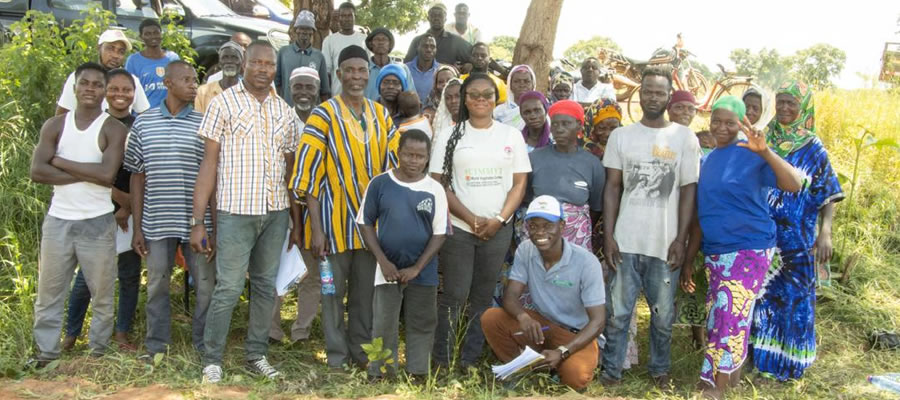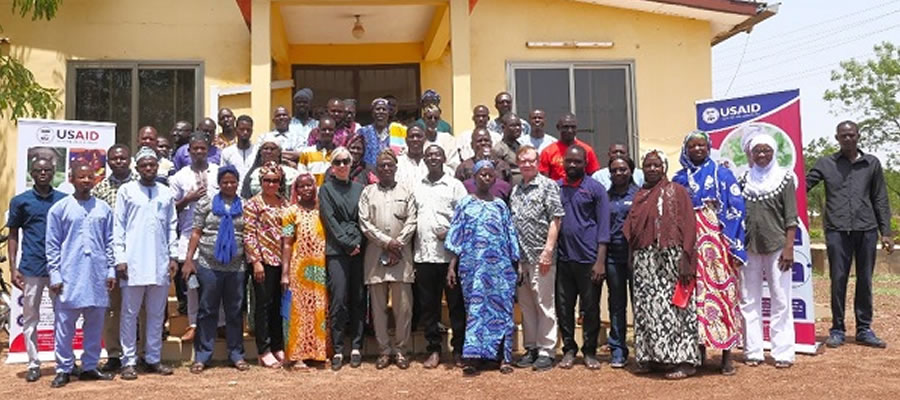

SOCIO-ECONOMIC CHARACTERISTICS
Micro Economy
The Municipality remains an agriculture-based economy. The sector engages about 97 percent of the labour force, majority of who produce staple crops on subsistence level. Cash crop production is very minimal and includes sheanut, Soya beans, cotton and cashew. Agro-processing is generally done by traditional methods and on very small-scale bases. There are, however, efforts by external support agencies to upgrade technologies, especially for women in the processing of sheanut, groundnuts, rice, cotton ginnery, and soap manufacturing. Below is a summary of major economic activities in the municipality.
- Agriculture basically at the peasant level,
- Trading in foodstuff such as maize, beans, rice and other grains,
- Sand winning, the bulk of which is used for construction work in Tamale Metropolis
- Fishing along the black Volta
- Sheanut processin Income
Income levels are generally low. This is due to the fact that a majority of the populace depends on rain fed agriculture. Income levels are low for women than for men. Gender distribution and access to resources is one factor for the poor income levels of women. The culture of the people posits the male sex at an advantage position in resource ownership such as land for farming and leadership positions. Positions held by women are those that may not command authority.
Thus, though income levels are low, the men can be said to be better off than women. Below is a graph on gender and land holding in the Municipality. Giving that agriculture is the mainstay , less access to land for agricultural purposes is a possible reason for the low level of income among women. Fig. 1 depicts the land distribution in relation to gender in the district.
CURRENT REVENUE AND EXPENDITURE SITUATION
Revenues Sources
The revenue sources of Savelugu Municipal could be grouped into internal and external sources. The internal source comprises the internally generated funds (IGF) and includes Rates, Lands, Fees, Licenses, Rent, and Investment and Miscellaneous income. The MA has a poor revenue mobilization capacity. The amounts of revenues collected have often fallen below the target. Fig 2 depicts IGF for the past three years. The reasons for the scenario is non payment of rates especially basic rate and lands whilst revenue leakages from revenue collectors is also a significant reason for low revenue mobilisation.
External Revenue Sources
There are various donor/NGO interventions. Notable amongst which include World Vision Ghana, UNICEF, GDCA, DWAP, NORPREP, CBRDP, EU/GOG Micro Projects Programmes and central government transfers such the DACF, HIPC and Personnel Emoluments. The DACF is a regular GOG source as specified in 1992 Republican Constitution which states that 5% of national revenue should be disbursed to District Assemblies based on a formula approved by parliament. Fig 3. depicts DACF for 2003-2005. Another GOG source is HIPC. However, this source has become dormant. Other significant external revenue sources are UNICEF, EU/Micro Projects Programme, DWAP, NORPREP, GDCA, WVG, Carter Centre and others.
Internal/External Sources of Revenue
Over 90% of revenue has often been made up of the external component. Fig. 4 is an example of the situation in 2005
Expenditure
Similarly, there are two expenditure sources namely recurrent expenditure and Capital expenditure.
Recurrent Expenditure
This category encompasses the routine expenditures that are incurred to enable the MA attain its vision and mission. This category includes Personnel Emoluments (PE) or salaries and wages, Traveling and Transport (T&T), General Expenditure (GE), Maintenance, Repairs and Renewals (MRR) and Miscellaneous Expenditure (Misc Exp).
It is significant to mention that the salaries of established post staff are paid for from central government funds. In most cases, the other categories of recurrent expenditure are financed from the IGF. It is equally significant to mention that Recurrent expenditure consumes a greater percentage of the IGF such that very little of IGF is spent on capital expenditure. It is also significant to mention that the DAs Recurrent expenditures are within budgeted allocations. Except for PE, which is largely influenced by increases in salaries of established post workers, the other expenditure heads for the previous plan period were within budget as fig 4 in pdf file depicts.
Capital expenditure
In its efforts to create the enabling environment for development, the MA implements various capital expenditure programmes and projects from the grants it receives from its development partners and central government. The Capital expenditure items can be grouped under Administration, Economic and Social Services expenditures. Below is Bar chart depicting capital expenditures for the period under review.
Capital/Recurrent Expenditure
Just as revenue from external sources surpasses revenue from internal sources,capital expenditure always exceeds recurrent expenditure. Below is also a graph depicting Capital expenditure and Recurrent Expenditure for 2005.
Though there are constraints and challenges in reducing expenditure, may be due to macro economic environment that the MA has no control over, the MA could still reduce running cost of official vehicles and thus maintenance of vehicles and similarly traveling and transport expenses.
Production and Gainful Employment
The Assembly is predominantly agrarian. Agriculture, basically, food crop cultivation is the main activity for about 97% of the populace engaged in agriculture producing staple crops on subsistence level. Industrial activities and trade and services constitute less than 3% of the production and gainful employment in the municipality.
Financial Institutions
Access to Financial Resources
There is only one financial institution, the Borimanga Rural Bank in Savelugu. The proximity of the Municipality to Tamale with financial institutions is an opportunity. However, farmers still have limited access to credit facilities from the banks because of lack of collateral security. The GDCP provides some form of credit to women groups. Other sources of financial resources are DACF poverty Alleviation loans and interventions especially in the Agricultural sector.
Women in Credit
Credit to women is poor. About 30% of credit goes to women. For example in 2005, under a Livestock Development project, 59 out of 224 credits to farmers went to women (ie 26%). Depicted in the graph is gender and credit beneficiaries from 2005-2006.
It is evident that women in credit are low. Even credit for sheabutter processing, an activity that engages most women in the district only 4 women as against 41 men received credit.
Energy
A greater percentage of the Municipality has no access to electricity. Out of the 149 communities only 24 are hooked to the national grid. This constitutes less than 20% of the communities in the Municipality.
Electricity in the Municipality is single phase, a situation which limits the Agro-processing activities such as electric powered machines like the ITFC storage facilities and grinding mills. Giving the important role energy plays in the development process on modern societies, a lot still needs to be done to get many communities power to promote economic activities.
To this end, the Assembly is working closely with the ministry of energy and VRA not only connect more communities to the national grid but also to up-grade the service in the Municipality to make it economically productive.
Date Created : 11/18/2017 8:08:03 AM










 facebook
facebook
 twitter
twitter
 Youtube
Youtube
 +233 593 831 280
+233 593 831 280 0800 430 430
0800 430 430 GPS: GE-231-4383
GPS: GE-231-4383 info@ghanadistricts.com
info@ghanadistricts.com Box GP1044, Accra, Ghana
Box GP1044, Accra, Ghana